On a whim—which is saying something, because I don’t typically buy things “on a whim”—I picked up a copy of last year’s reprint of 1880: China during SPIEL 2022. Based on the 2010 game of the same name, Lookout Games produced an updated version with a better-looking map, box and components.
But Lookout doesn’t do much in the 18xx space; in fact, 1830: Railways and Robber Barons is the only other major 18xx game that they currently publish. So, it was curious to see 1880: China under the Lookout banner at the show. I laid down some cash and quickly proceeded to get the game home and…not play it in any form for six months.
Earlier this year, when I began using the fantastic site 18xx.games, I learned 1880: China in the virtual space. That way, I could take more time to learn the systems and what made the game unique. Around this same time, I began to read reviews about 1880: China and 18xx loyalists seemed to be very excited about it.
Now I see why. Across 17 total plays online and in person, this is the best version of the original 18xx system I have played. 1880: China is a beast because so many of the game’s rules are different from 1829, the first 18xx game designed by Francis Tresham. 1880: China is a massive piece of chicken, between the map and sheer volume of private companies, minor corporations and public companies available for players.
I will try to scratch the surface of many of these differences here. Just know that once you have gotten your feet wet with other 18xx games, you need to try 1880: China stat!
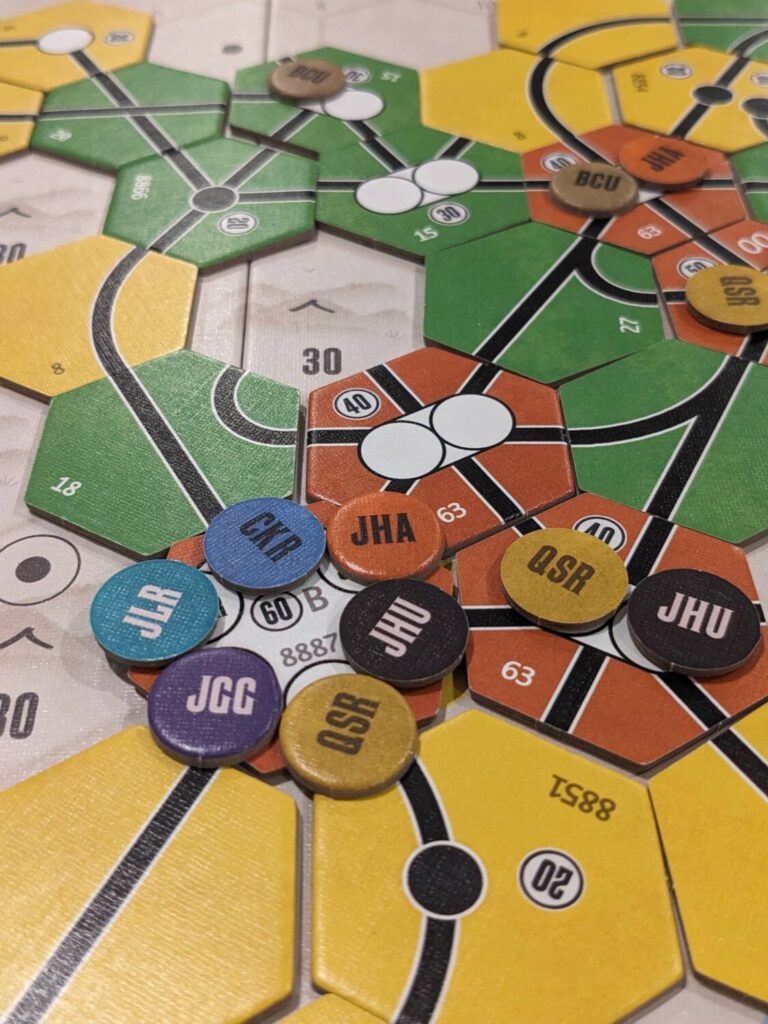
There Are a Few Similarities
1880, designed by Leonhard “Lonny” Orgler and Helmut Ohley (longtime train game designers who also designed Russian Railroads and 1848: Australia), is a 3-7 player economic game that plays in…well, uh, a very long playtime.
In the wrong hands, in-person games of 1880 could take 6-8 hours. For that reason alone, I only played 1880 once in person. I just don’t have that kind of time on most weekends to knock out a large game of anything, really. Online, though, you can do games of 1880 with friends or complete strangers that play out over an asynchronous turn structure that might take a month or two. While I would rather play 1880 in person, it takes a special group of folks to commit to having a weekly or monthly group that can stomach poker chips and yellow track tiles for such a long session.
So, 1880 is long, but so are many other 18xx titles. And like other games that use the 18xx system, there are some similarities between those and 1880. There are stock rounds and operating rounds; a map of China represents the play area where corporations will build track, run routes, and collect revenues. A private company draft kicks off each game, with players having the chance to bid on eight different privates. 1880 features all of the same track other 18xx games have, running from yellow to green to brown to gray, with city and town tiles included.
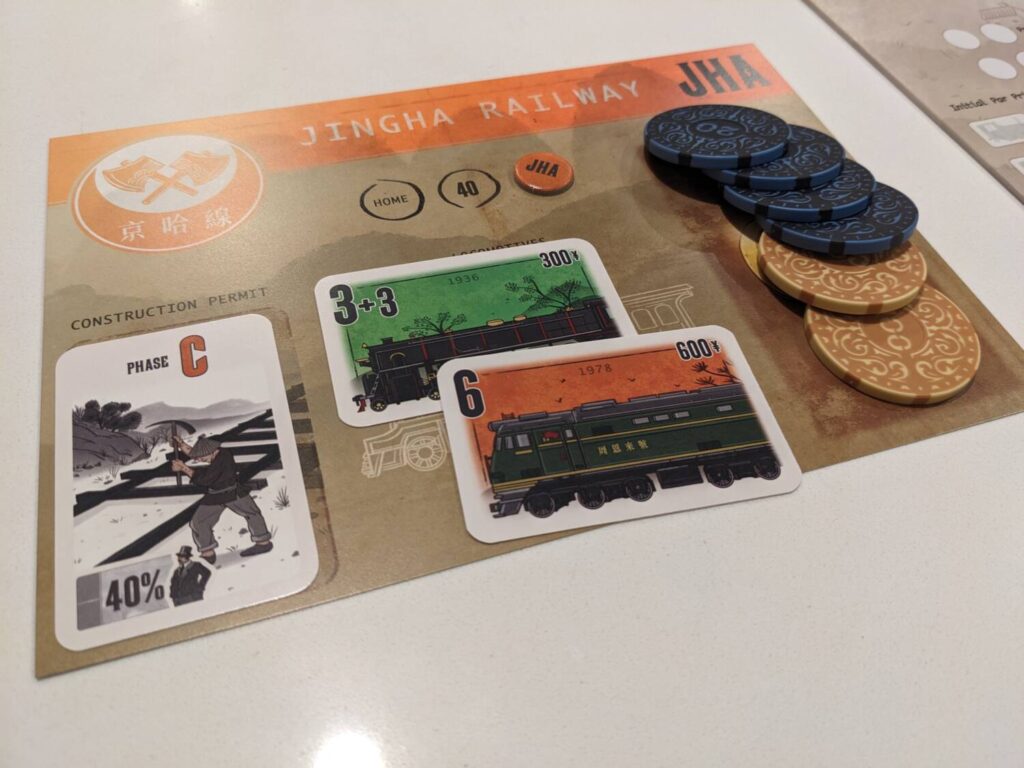
But during my first pass at the rulebook, things began to change. Adapt, maybe. And that’s when I realized that 1880 would become my favorite 18xx game because it turns so many standards on their heads.
That starts early in each game, with the Foreign Investors. On the massive map of 1880, there are seven starting locations for each of the seven Foreign Investors. These Investors operate like the minor companies in a game like 1846: The Race for the Midwest or 1861: Railways of the Russian Empire, in that they accumulate small amounts of revenues each operating round and their treasuries can later be absorbed into major companies. But unlike those other games, Foreign Investors never own any trains. They take an imaginary train from the pool of the current train phase, and the owner runs the best possible route for the Investor.
After privates are acquired, and Foreign Investors are selected (for free), players par a major corporation with a starting share price ranging between 70, 80, 90, and 100 yuan per share. However, unlike the other 18xx games I have tried, 1880 does something different—players get to choose the size of their Director’s Certificate.
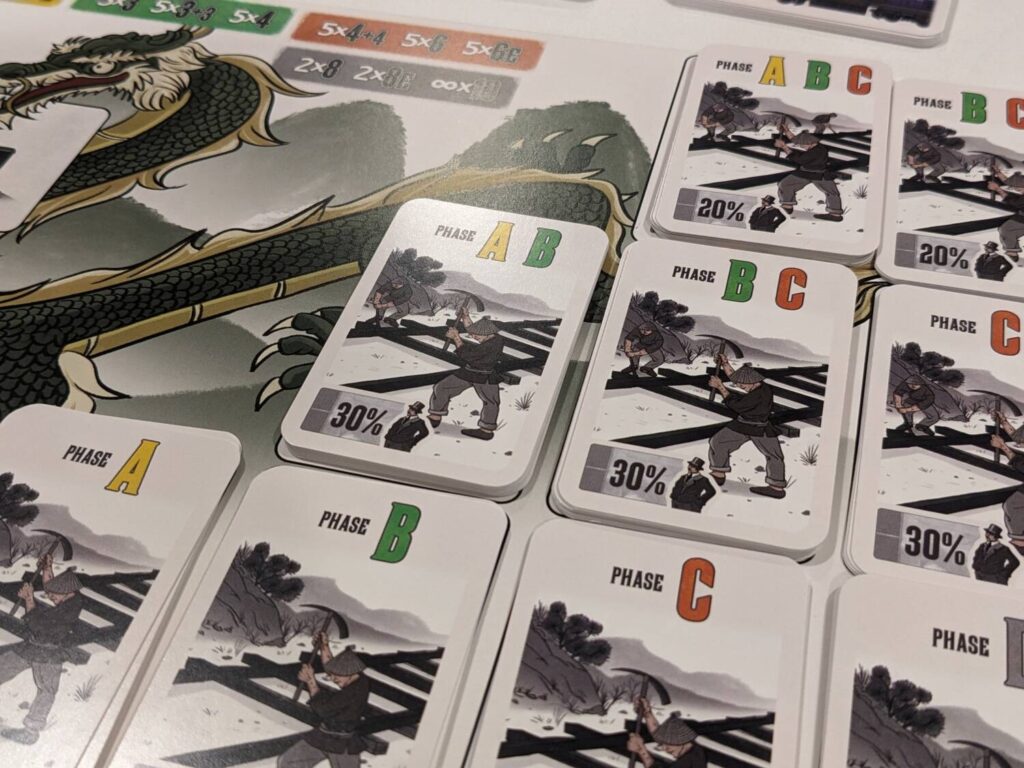
This is based on two factors:
- When a player wants to build track: phases A, B, C, or D.
- How much they want to plop down to have access to those phases: 20% of the total company value (to build in three different phases), 30% (two phases), or 40% (one phase).
This choice is more fascinating than it sounds, and it certainly is more interesting when players start a second or third company, and not their first. That’s because this affects the number of certificates (pieces of stock paper) a player can hold. Whether they choose 20%, 30% or 40%, that only counts as one certificate. That means a player who feels good enough to start two companies at 40%, and another at 20%, has only used three of their certificate spots to start corporations, and can spend the rest to grow that corporation or invest in other corporations.
But wait, there’s more! When starting one of the 14 major companies (FOURTEEN COMPANIES!!!), players have to choose a starting par price, and that par price—not the current market price of a corporation—marks when that corporation will take their turn during the operating round. Games of 1880 end three rounds after the purchase of the final 8 train, starting with the last company to buy a train. Because of this, going as early as possible in turn order is vital.
The float rules are different, too. Depending on the game phase, a player needs anywhere from 20-60% of a company’s shares to be bought by the director to begin operations. Players get half of their operating capital (five times the par price of that company) when the company has floated, and the other half comes when five shares are owned during any point in any future stock round. If a player is starting their first company, the player gets a number of shares equal to their investment in the Director’s Certificate, and their Foreign Investor also gets one share.
Now, it is the goal of that player to connect the routes between the major company and the Foreign Investor’s minor company operation. And then the first of at least two, maybe three, separate games begins—how do I operate a great major company, while also spreading out across the map to ensure I connect with my Investor’s company? Because when that connection happens, I get all of the money in the Investor’s treasury plus a 50-yuan bonus.
I would argue that this initial game, connecting your Foreign Investor to your first major, is interesting enough to be its own game, another reason why I love playing 1880 so much. But there are a couple more games to be played!
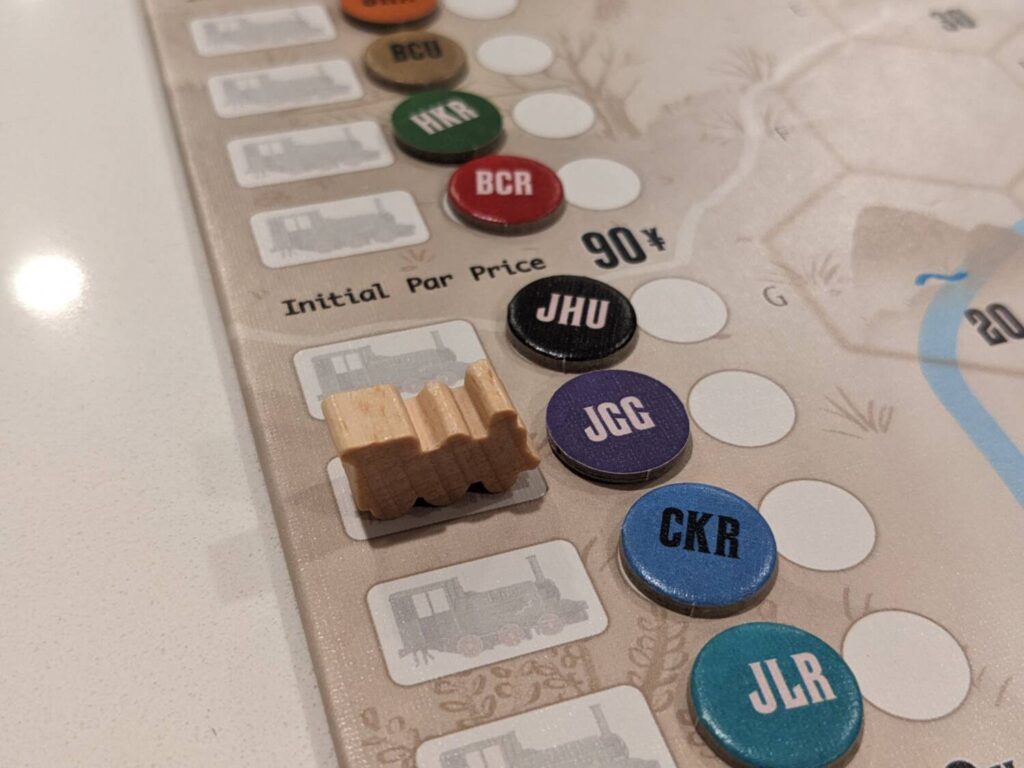
There’s So Much Here!!
While players are working to connect their first railroad line to their Investor line—a process that might take one round, or many more—they are working to maximum shareholder value, like they would in every 18xx game.
But a few other things are different here. Trains, for one. There are 12 different train types. Like other games in the 18xx systems, trains are numbered and valued based on how many revenue centers they can hit. There are towns all over the map of 1880, but towns pay more than other 18xx games—20 yuan, instead of 10. A 2 train can hit two locations of any type, but a 2+2 train can hit two cities and two towns on its route.
Finding ways to maximize the cash made on routes is always important. But in 1880, it is fun to build routes that take advantage of your “plus” trains versus your regular trains. Trains rust in 1880, but players must worry about both players and the game’s train system working against them. If a certain type of train isn’t bought for a full cycle (meaning every company has taken at least one operating turn), the rest of that train type are immediately removed from play.
And, this is the only way that stock rounds start. Yes—stock rounds are not arranged in the same way they are in every other 18xx game I have played. That means operating rounds could last for a while, if someone buys a train here and there, but doesn’t exhaust that type of train in the pool. This also means that finding the right balance of running trains to earn revenues, and withholding to prep for future train purchases, is tougher here. When stock rounds occur, I have found it imperative to have cash to buy a share or two every chance I get.
Speaking of the stock market—in 1880, when someone buys the first 4 train, the entire market freezes thanks to the Communist Takeover. (In the game’s lore, 1949 signifies the beginning of Mao Zedong’s Communist Party rule, but it’s really just a chance for the game to change a bunch of minor rules.)
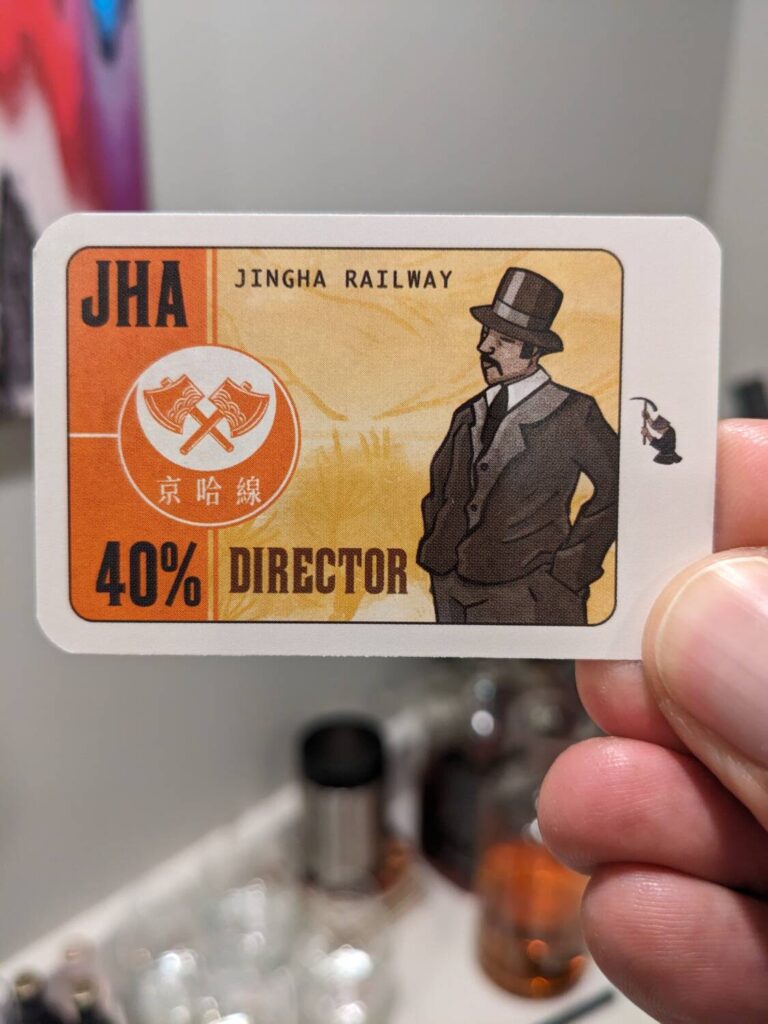
Routes still earn revenue for shareholders, but the company’s share price doesn’t move until the first 6 train purchase. This ultimately becomes the best, and maybe only, time for players to safely withhold revenues to get ready to buy permanent trains when the Communist Takeover ends (when the Shanghai Stock Exchange opens, which in real life was 1990). Every time I’ve done well in 1880, I’ve managed this portion of the game well, and every time I’ve blown it (usually by miscalculating how many corporations in front of my company will buy a permanent train), it has had dire consequences.
Just another game within the game!
The market is really cool in 1880. I love the permanent turn order set with the initial share price of each major. I love that as players move to the right on the market chart, their company can earn anywhere from 5-40 yuan per share in bonus cash for strong performance. That means that a route that might pay 300 yuan will pay 400 yuan if it is sitting in the orange section of the market (which grants a 10 yuan per share bonus)…and even if the routes themselves aren’t that special, the feeling that you have a well-run company means bonus cash. Makes sense in real life, and it makes sense in game terms.
More changes abound. Unlike other 18xx games, 1880 lets players buy every single share of a company they run, not just 60% of it. If I run a great company, I want to own as much as I can, right? Players can’t go bankrupt, so if an emergency train purchase needs to happen, players can sell shares like normal but then spend the rest of their cash then take a loan and stay in the game. The competitive portion of your game is probably going to be over, but at least the game isn’t submarined by a player that had a tough run.
Players can’t dump bad companies onto other players until very late in 1880: China. As someone who hates the idea that I could ruin someone’s experience in the second operating round of a game by getting rid of an underperforming company, I love that this rule exists.
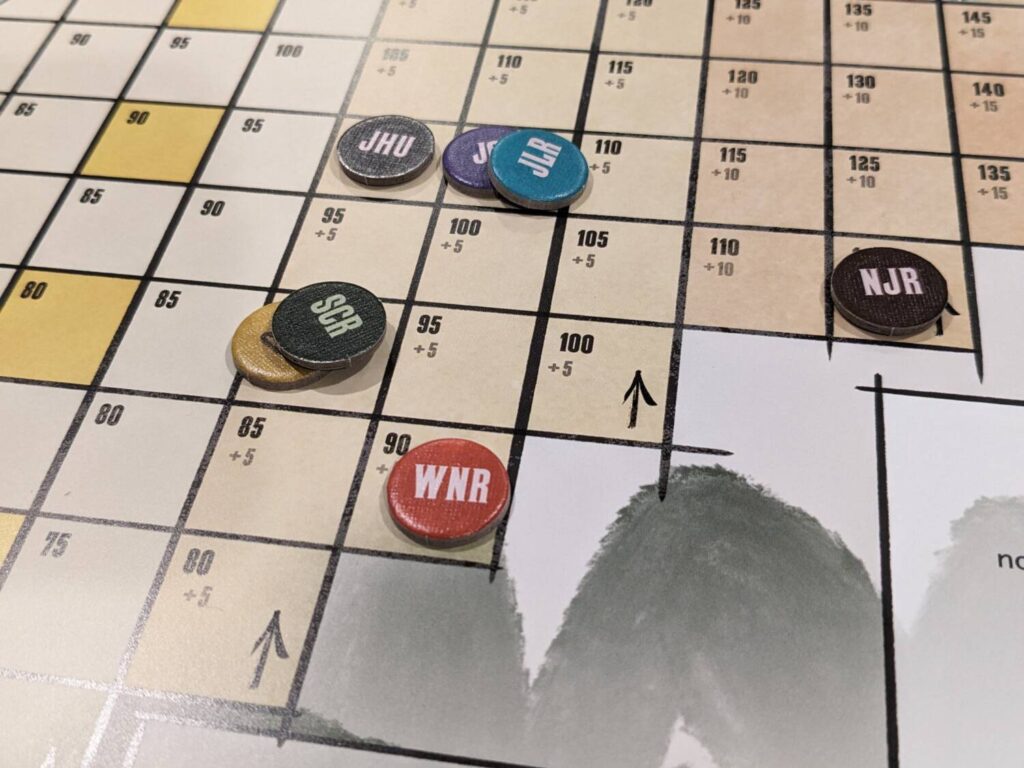
Plus, Plus
1880: China is one of the best experiences I have had in gaming this year, and maybe beyond 2023. It just feels epic in tone—the way the game’s stages play out, the amount of change that takes place from a blank map to one where players are using express trains to zip around, the train rush, the growth of each player as they move from owning a small business to running something really robust.
However, for players new to the 18xx space, 1880 is a bad idea. It throws too many new things at someone who has never tried a game like this, and even if you’ve played more traditional games like 1830 or 18Chesapeake, going from those directly to 1880 might be a tough learning curve.
But for 18xx veterans, oh my goodness. I’ve only tried 13 different 18xx games, but this is the most complicated one I have tried and I love everything 1880 is trying to accomplish. I’m having so much fun exploring what the game can do even in defeat…operating a good business is one thing, but timing how my Foreign Investor cash can inject my first railroad with much-needed capital in the mid-game is a rich decision space. I love the late game, when players realize that they didn’t have enough cash lying around to buy another train when their 4+4 finally rusted when the first 8E train was purchased.
In terms of gameplay, 1880 is exceptional. As a production, 1880 is just fine. Everything looks great, the map clearly lays out what you need, and the included paper money is OK if that’s the route you want to take instead of poker chips. But as a production, this is nowhere near the quality of something like the new edition of Shikoku 1889, which is the gold standard for 18xx productions in terms of quality table presence.
But the gameplay in 1880 is that strong. If you are looking to expand your horizons on the train game front, look no further!


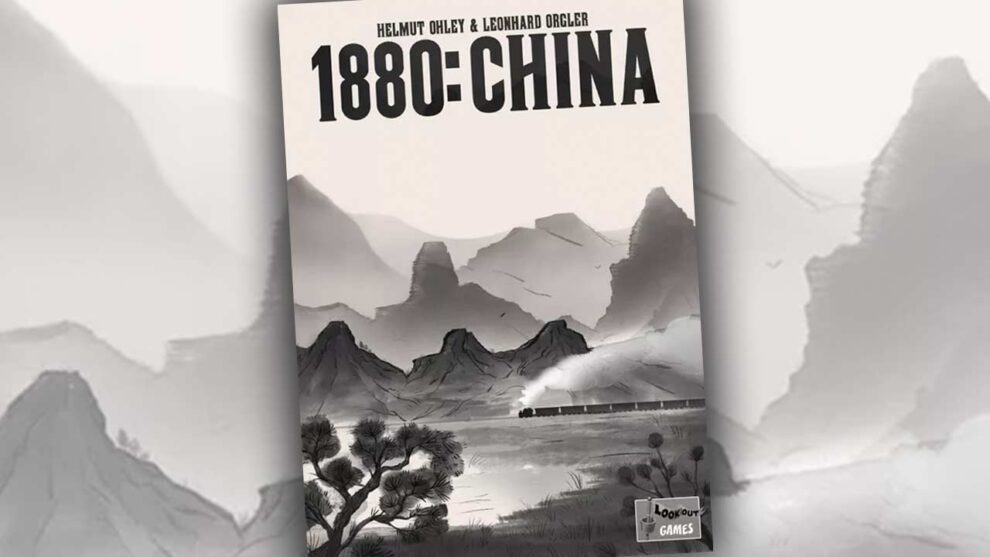









I’ve played the short variant twice in person. First time we didn’t complete. Second time took us about 5.5 hrs, but we complete. I think 4-5 hrs would be possible with semi regular play.